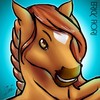Sign In
CloseJoin up - equine diaries & body language study by Amethyst Mare
I had a strange (but good) experience today. Mainly as I don't expect much to go right the first time with working our horse, Moogie. I go in with confidence, but no expectations. Often, the first time will be bad and then, after we've had time to sleep on it, the second time is much, much better. So, when things go extremely well, it's a bit of a revelation!
Join up is when you send the horse away and drive him on until they demonstrate the signs that they want to come in and join you, that they don't want to flee anymore but see a safe space with you. This is, of course, very basic, but I'm sure you don't want every nuance here! I could go into a lot more detail, but I honestly heard about join up initially from the old Heartland horse books way back when I was young. I always wanted to try it as a trust building and leadership exercise with a horse.
Note that, when you drive the horse on, you send him out with a long line or lunge whip and your body language (shoulders square, eyes on his like a predator). The whip doesn't touch the horse, but the line can, as it's so light and reinforces the aid and the distance to drive the horse out. I slapped the coiled rope against my legs and shoulders to drive him on with the sound a lot and made a 'claw' with one hand, like in the example video below.
Join up as explained by Monty Roberts: https://www.youtube.com/watch?v=vYtTz9GtAT4
So, I tried this with Moogie. He's been napping a lot (racing back to the gate and stopping at the gate, wanting to stop work), so I thought it was worth a try. We have a small pen within the field pen now and I wasn't feeling well today, so it seemed like a good, low key thing for me to do.
It was hard work.
I got him in, orientated him with all four sides of the pen and sent him away. I really learned a lot about body language here as fixing my eyes on his worked very well. I'm usually so careful not to look directly at a horse's eyes and not stare at him that I didn't realise how useful doing this deliberately could be. Sending him on was very easy with body language and I learned that I could be subtler than I have been.
There are four signs that say that the horse is ready to come in and join you, with you as the leader. They are: the horse making gradually smaller circles (coming closer to you), chewing and licking, lowering the head and (usually first of all) fixing the inside ear on you while the outside listens to all other sounds.
I got all of these signs with Moogie and I'm thrilled. Sometimes, of course, having the head down or chewing/licking can indicate tiredness, but this will not be the case in a very short session. Our join up was reasonably short and I think I may have had him going for ten minutes before I was happy for him to come and join me. As soon as I offered him my shoulder and made my body language passive, he walked straight up to me and nudged my hand. And then he followed me all over the pen as if he was tied to me. No rope. Nothing. Just trust.
(There is some debate over the training method, but, to be honest, there's always debate in the horse world. Everyone has a different opinion and my opinion on this is that it's an useful tool for me in this instance. It's certainly a lot better than brute force!)
After the session, he allowed me to put fly spray all over him without moving. This normally makes him a bit skittish, but he absolutely stood like a rock. I'm hoping this is something that will continue, but otherwise that'll only be one more thing that I'll be keeping on working at.
Now... This isn't simply an equine note. Body language has incredible importance in reading and writing and storytelling. So much can be said in body language that it is important for writers to take note of this. And furry writers? You have an animal in addition to human beings (assuming your anthro is not a hybrid) to play with the body language of. You have so much scope - go out there and use it! I'm trying to implement this the best I can, but you can probably guess that I am best at equine body language.
So. Body language. The unspoken language. Use it to your best advantage in writing and everyday life.
And around horses. <3
Amethyst
Journal Information
- Views:
- 46
- Comments:
- 0
- Favorites:
- 0
- Rating:
- General

